How Are Smart Assistants Changing the Online Shopping Experience? Smart assistants like Alexa and Google…
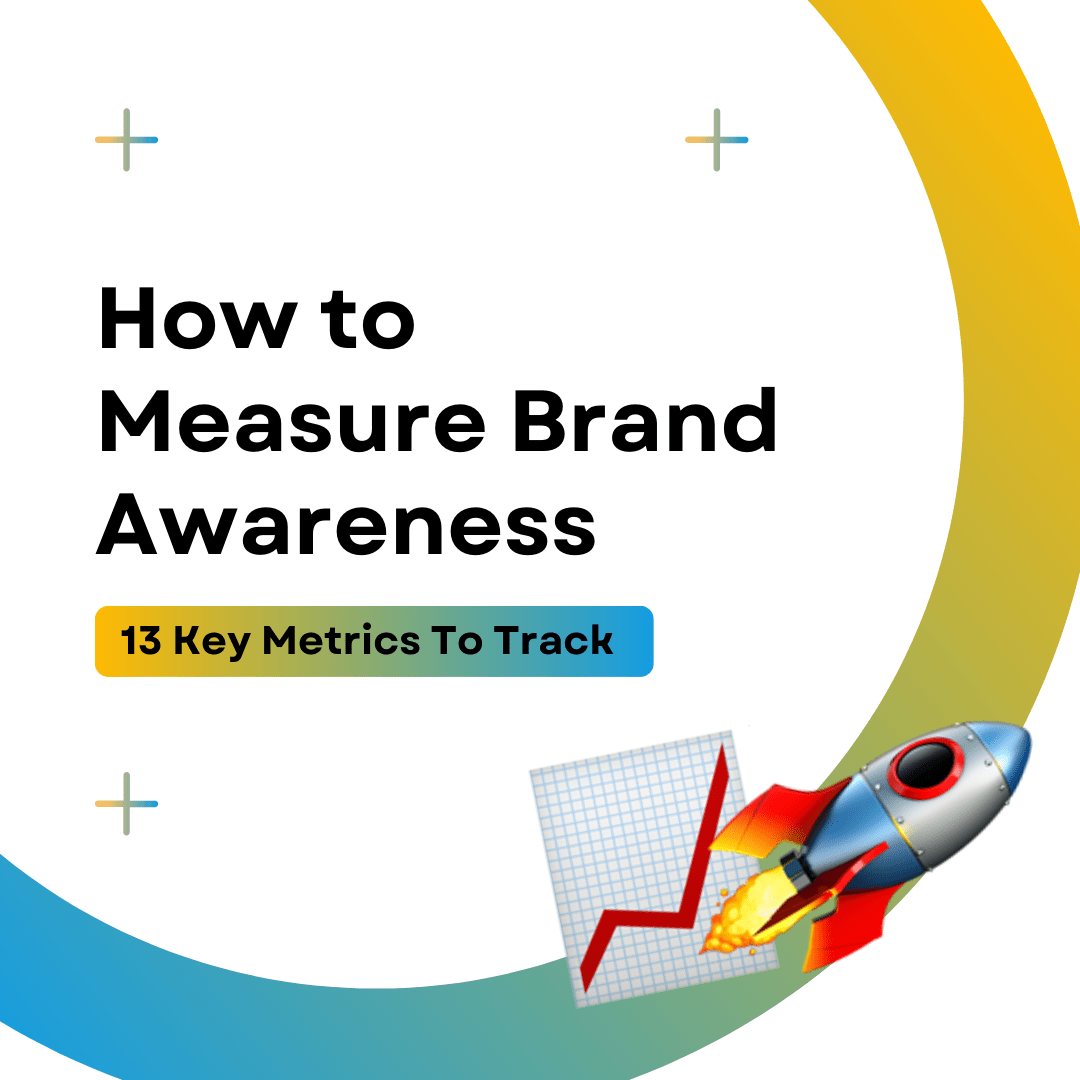
How to Measure Brand Awareness: 13 Key Metrics To Track
How to Measure Brand Awareness: 13 Key Metrics To Track
Brand awareness is the extent to which consumers recognise and remember your brand. In digital marketing, this refers to how well your brand is known and recalled by your online audience. It’s a crucial aspect of successful marketing strategies, as understanding and measuring brand awareness can significantly impact business growth and customer loyalty. In this guide, we’ll cover 13 key metrics to help you track and enhance your brand awareness.
13 Key Metrics to Measure Brand Awareness
1) Brand Recall
Brand recall measures how well consumers remember your brand without any prompts. This metric is vital for understanding the depth of your brand’s impression on consumers. Here are specific ways to measure brand recall tailored to a Singaporean audience, along with potential tools and examples.
Specific Ways to Measure Brand Recall in Singapore:
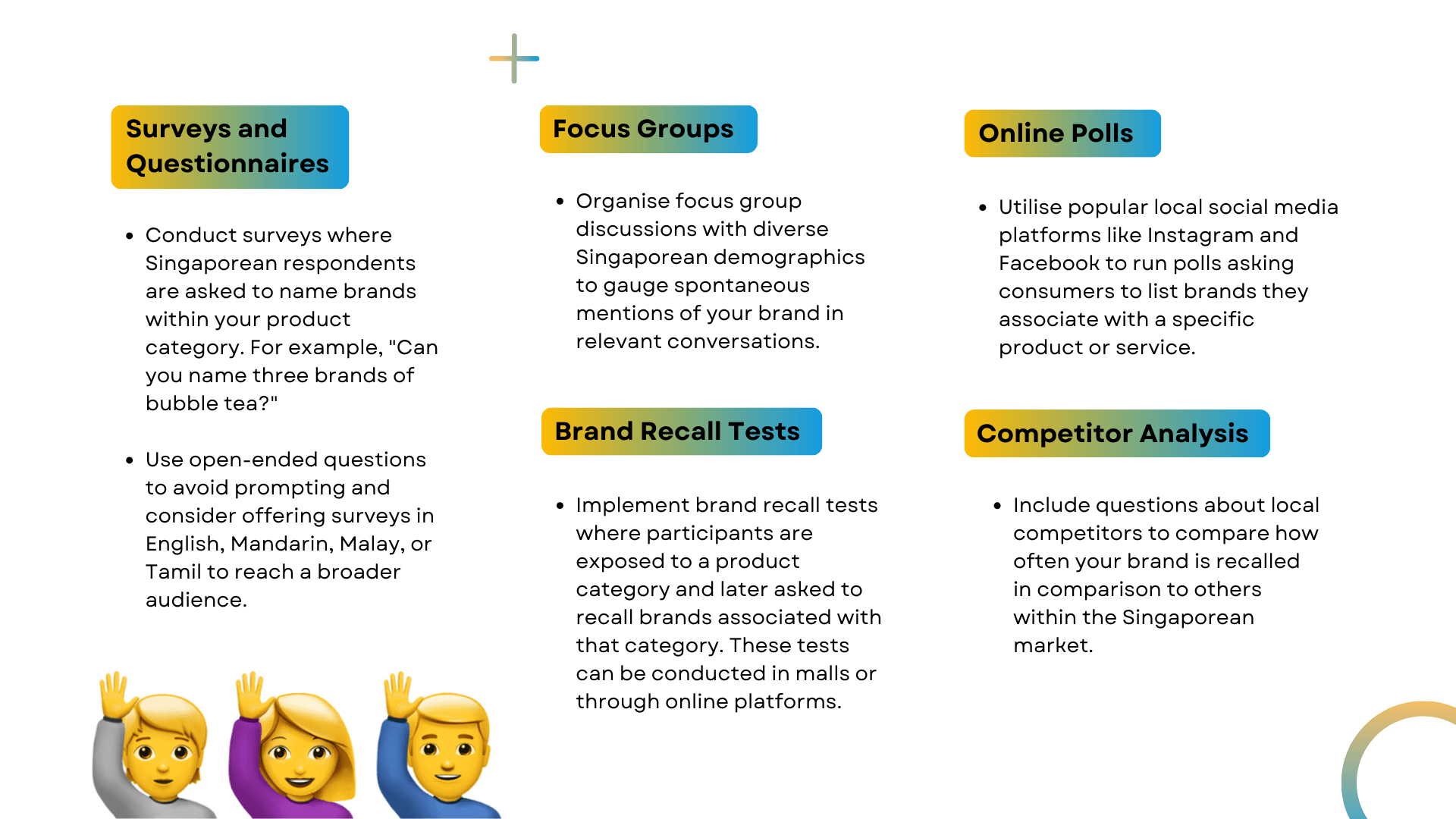
- Surveys and Questionnaires:
- Conduct surveys where Singaporean respondents are asked to name brands within your product category. For example, “Can you name three brands of bubble tea?”
- Use open-ended questions to avoid prompting and consider offering surveys in English, Mandarin, Malay, or Tamil to reach a broader audience.
- Focus Groups:
- Organise focus group discussions with diverse Singaporean demographics to gauge spontaneous mentions of your brand in relevant conversations.
- Online Polls:
- Utilise popular local social media platforms like Instagram and Facebook to run polls asking consumers to list brands they associate with a specific product or service.
- Brand Recall Tests:
- Implement brand recall tests where participants are exposed to a product category and later asked to recall brands associated with that category. These tests can be conducted in malls or through online platforms.
- Competitor Analysis:
- Include questions about local competitors to compare how often your brand is recalled in comparison to others within the Singaporean market.
Potential Tools:
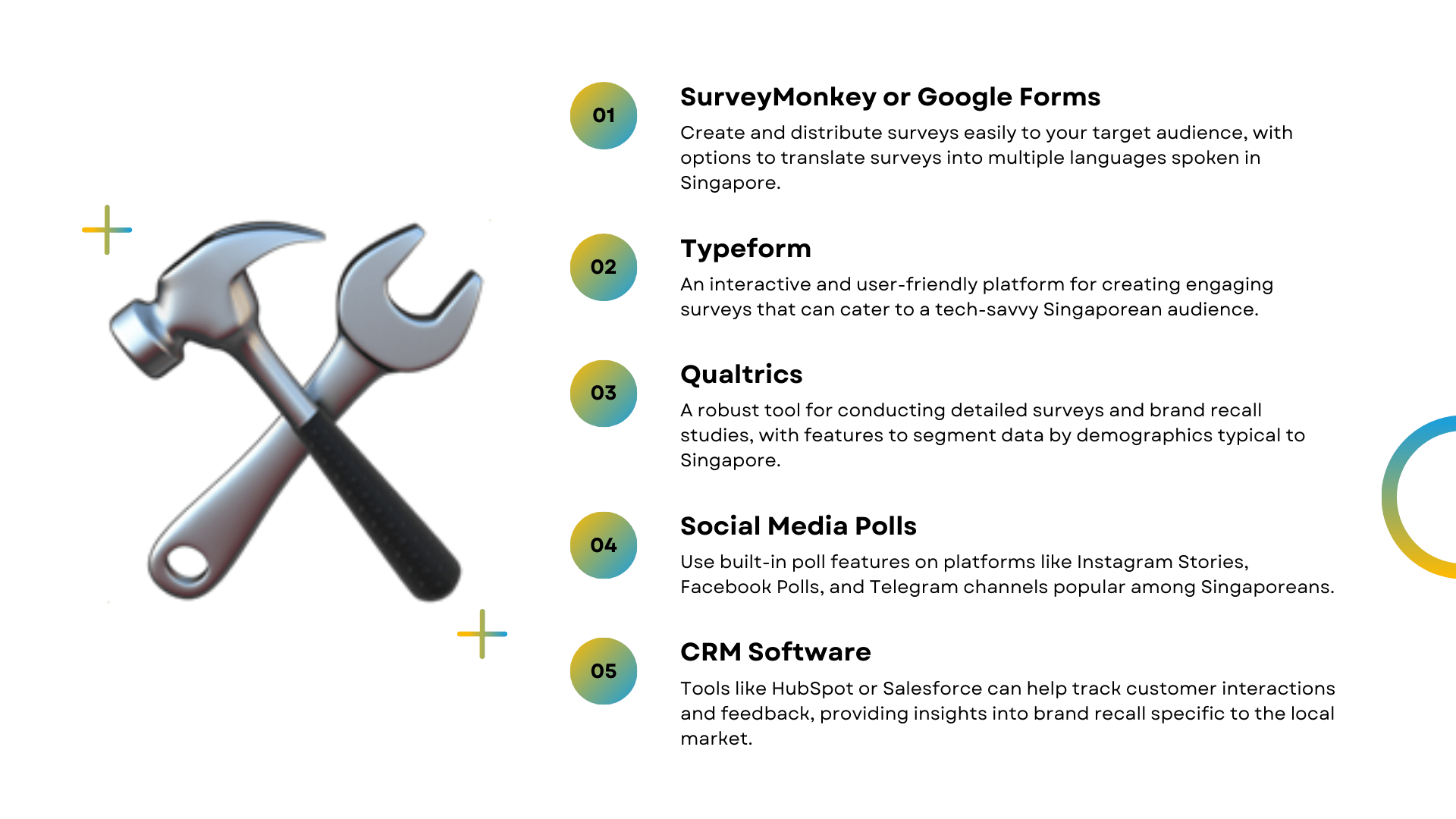
- SurveyMonkey or Google Forms:
- Create and distribute surveys easily to your target audience, with options to translate surveys into multiple languages spoken in Singapore.
- Typeform:
- An interactive and user-friendly platform for creating engaging surveys that can cater to a tech-savvy Singaporean audience.
- Qualtrics:
- A robust tool for conducting detailed surveys and brand recall studies, with features to segment data by demographics typical to Singapore.
- Social Media Polls:
- Use built-in poll features on platforms like Instagram Stories, Facebook Polls, and Telegram channels popular among Singaporeans.
- CRM Software:
- Tools like HubSpot or Salesforce can help track customer interactions and feedback, providing insights into brand recall specific to the local market.
Example of Good Brand Recall in Singapore:
Tiger Beer is a prime example of strong brand recall in Singapore. When consumers think of local beer, Tiger Beer is often one of the first brands that come to mind. This high level of recall is a result of consistent branding, extensive advertising, and a strong presence across various media platforms in Singapore. Tiger Beer’s association with national pride and its sponsorship of local events further boosts its brand recall and consumers’ minds.
2) Brand Recognition
Brand recognition differs from recall in that it measures how well consumers can identify your brand when prompted with visual or auditory cues. This metric is crucial for assessing the effectiveness of your branding elements. Here are specific ways to measure brand recognition tailored to a Singaporean audience, along with potential tools and examples.
Specific Ways to Measure Brand Recognition in Singapore:
- Visual Recognition Surveys:
- Conduct surveys where respondents are shown brand logos, product images, or packaging and asked if they recognise the brand. For example, showing the logo of a popular local food chain like Old Chang Kee and asking if participants can identify it.
- Auditory Recognition Tests:
- Play jingles, taglines, or audio clips from advertisements and ask participants if they can recognise the brand. This can be particularly effective in a multilingual context, with audio clips in English, Mandarin, Malay, and Tamil.
- Social Media Quizzes:
- Use platforms like Instagram Stories or Facebook to create interactive quizzes where users match logos or taglines with the correct brand. These quizzes can reach a broad audience and provide instant feedback.
- In-Store Experiments:
- In collaboration with local retailers, conduct in-store tests where shoppers are shown various product packaging or logos and asked to identify the brand. This can provide real-time data on brand recognition.
- Eye-Tracking Studies:
- Use eye-tracking technology to see which brand elements (logos, colours, packaging) catch the attention of consumers in various retail settings, such as in supermarkets or hawker centres.
Potential Tools:
- SurveyMonkey or Google Forms:
- Create and distribute visual and auditory recognition surveys to a broad audience, ensuring options for multiple languages common in Singapore.
- Qualtrics:
- A comprehensive tool for creating detailed surveys and recognition tests, with advanced analytics to interpret results.
- Social Media Platforms:
- Leverage Instagram Stories, Facebook, and Telegram to conduct recognition quizzes and polls, engaging users where they spend their time.
- Tobii Pro Eye Trackers:
- Advanced eye-tracking technology to measure what branding elements attract attention and how quickly consumers recognise them.
- Mobile Ethnography Apps:
- Use apps like dscout to capture real-world interactions with brands, providing insights into how consumers recognise and respond to branding elements in everyday settings.
Example of Good Brand Recognition in Singapore:
BreadTalk is a well-recognised brand in Singapore. When shown the BreadTalk logo or its distinctive store design, most Singaporeans can easily identify it. The brand’s consistent use of white and orange colours, along with its unique bakery layout and innovative bread creations, make it highly recognisable. BreadTalk’s frequent presence in malls and its signature product packaging further enhance its brand recognition.
3) Brand Sentiment
Brand sentiment analyses the emotions and opinions consumers have about your brand. This metric is vital for understanding public perception and identifying areas for improvement or strengths to leverage. Here are specific ways to measure brand sentiment in Singapore, along with potential tools and examples.
Specific Ways to Measure Brand Sentiment in Singapore:
- Social Media Monitoring:
- Monitor social media platforms like Facebook, Instagram, and TikTok, which are popular in Singapore, for mentions of your brand. Look for keywords and hashtags related to your brand to gauge sentiment.
- Review Analysis:
- Analyse reviews on local platforms such as HungryGoWhere, Yelp Singapore, and Google Reviews. Categorise reviews as positive, negative, or neutral to understand the general sentiment.
- Survey Feedback:
- Conduct surveys and feedback forms specifically designed to capture consumers’ feelings about your brand. Include open-ended questions to gather detailed opinions.
- Forum and Community Scanning:
- Scan popular forums and community platforms like HardwareZone and Reddit Singapore for discussions about your brand. Analyse the tone and content of the conversations.
- Customer Service Interactions:
- Analyse customer service interactions through call transcripts, chat logs, and emails. Categorise the sentiments expressed during these interactions.
Potential Tools:
- Brandwatch:
- A powerful tool for social media monitoring and sentiment analysis. It can track mentions across various platforms and provide insights into overall sentiment.
- Hootsuite Insights:
- Use this tool to monitor social media channels and gather sentiment data. It helps in identifying trends and understanding consumer emotions.
- Google Alerts:
- Set up alerts for your brand to receive notifications about new mentions online, allowing you to quickly assess sentiment.
- SurveyMonkey:
- Create sentiment-focused surveys to directly ask customers about their feelings and opinions regarding your brand.
- Sprout Social:
- A comprehensive social media management tool that includes sentiment analysis features to track and analyse brand mentions and engagement.
Example of Good Brand Sentiment in Singapore:
Singapore Airlines consistently enjoys positive brand sentiment. Known for its exceptional customer service and premium in-flight experience, the airline receives high praise on social media, review sites, and travel forums. The positive sentiment is reflected in customer reviews that highlight its comfortable seating, excellent food, and attentive staff. Singapore Airlines’ commitment to quality and innovation fosters a strong emotional connection with its customers, contributing to a largely positive brand sentiment.
4) Share of Voice (SOV)
Share of Voice (SOV) measures the percentage of all online content and conversations about your industry that mention your brand. This includes media coverage, social media mentions, and online reviews. Here’s how to measure SOV effectively in Singapore, along with tools and examples of successful SOV metrics.
Specific Ways to Measure Share of Voice in Singapore:
- Media Monitoring:
- Track mentions of your brand across Singaporean news outlets, blogs, and online magazines. This can include publications like The Straits Times, Channel NewsAsia, and Today.
- Social Media Analysis:
- Monitor social media platforms popular in Singapore, such as Facebook, Instagram, LinkedIn, and TikTok, for mentions of your brand. Use hashtags, keywords, and mentions to gauge SOV.
- Competitor Comparison:
- Compare your brand’s online presence against competitors by tracking the volume of mentions and discussions about each brand within your industry.
- Online Reviews:
- Analyse reviews on platforms like Google Reviews, Yelp Singapore, and TripAdvisor to see how often your brand is mentioned compared to competitors.
- Community and Forum Monitoring:
- Scan local forums like HardwareZone and Reddit Singapore for discussions about your brand versus competitors.
Potential Tools:
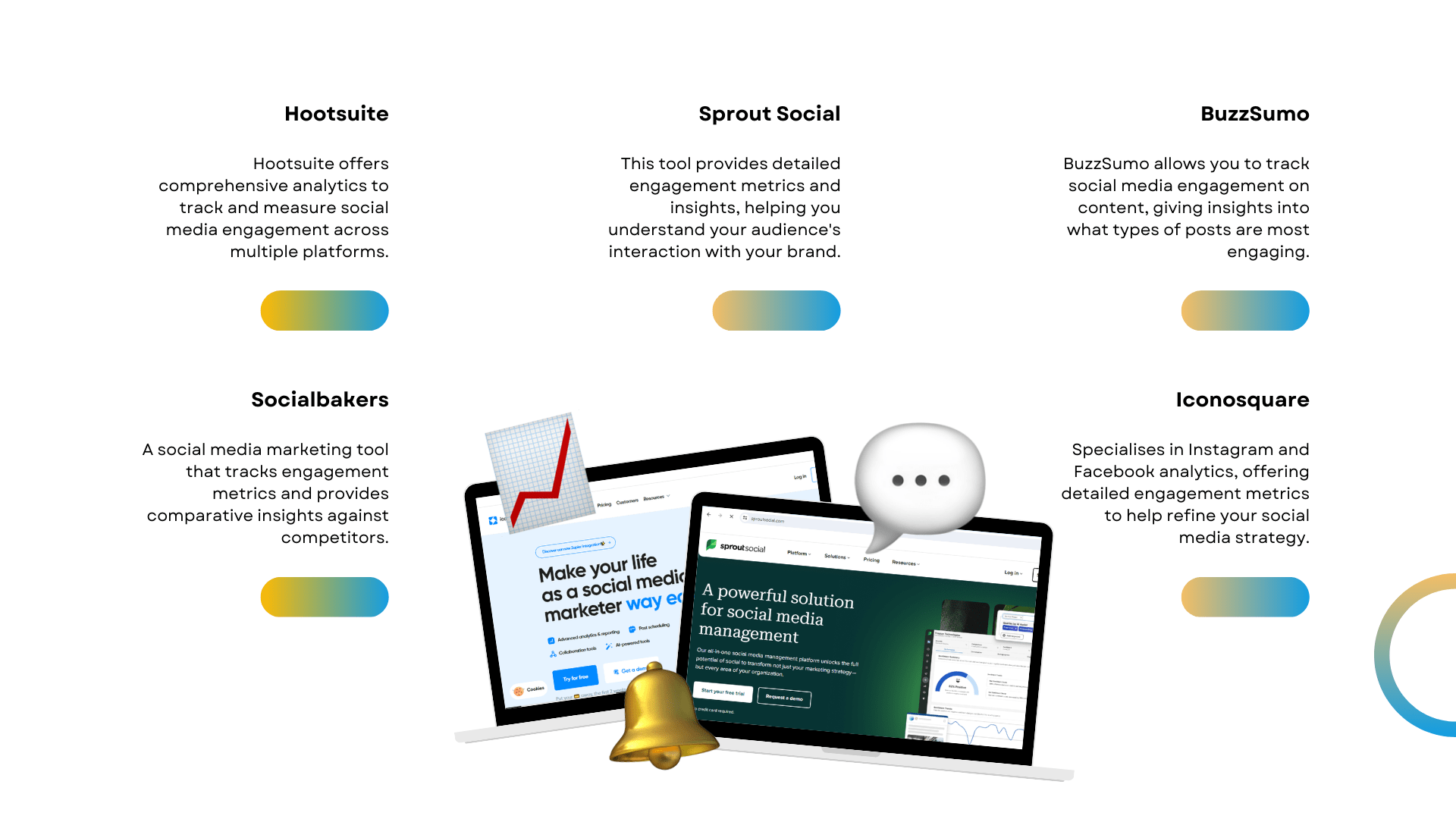
- Mention:
- An online monitoring tool that helps track mentions of your brand across social media, blogs, and news sites, providing insights into your SOV.
- Brandwatch:
- A comprehensive social media analytics tool that tracks SOV by monitoring online conversations and content mentioning your brand.
- Hootsuite:
- Use Hootsuite to monitor social media channels and track mentions of your brand relative to competitors.
- BuzzSumo:
- This tool allows you to analyse what content performs best for any topic or competitor, giving insights into your SOV.
- Sprout Social:
- Provides robust social media analytics to measure your SOV and compare it with industry benchmarks.
Example of Good Share of Voice in Singapore:
Grab has a high Share of Voice in the Singaporean ride-hailing and delivery industry. The brand is frequently mentioned across social media, news outlets, and online reviews. Grab’s extensive media coverage and active social media engagement contribute to its dominant market presence. The high SOV reflects Grab’s effective marketing strategies and strong customer engagement, reinforcing its market leadership in Singapore.
5) Social Media Engagement
Social media engagement metrics, including likes, shares, comments, and mentions, reveal how actively your audience interacts with your brand on social platforms. High engagement levels often correlate with higher brand awareness and loyalty. Here’s how to measure social media engagement effectively in Singapore, along with tools and examples of successful engagement metrics.
Specific Ways to Measure Social Media Engagement in Singapore:
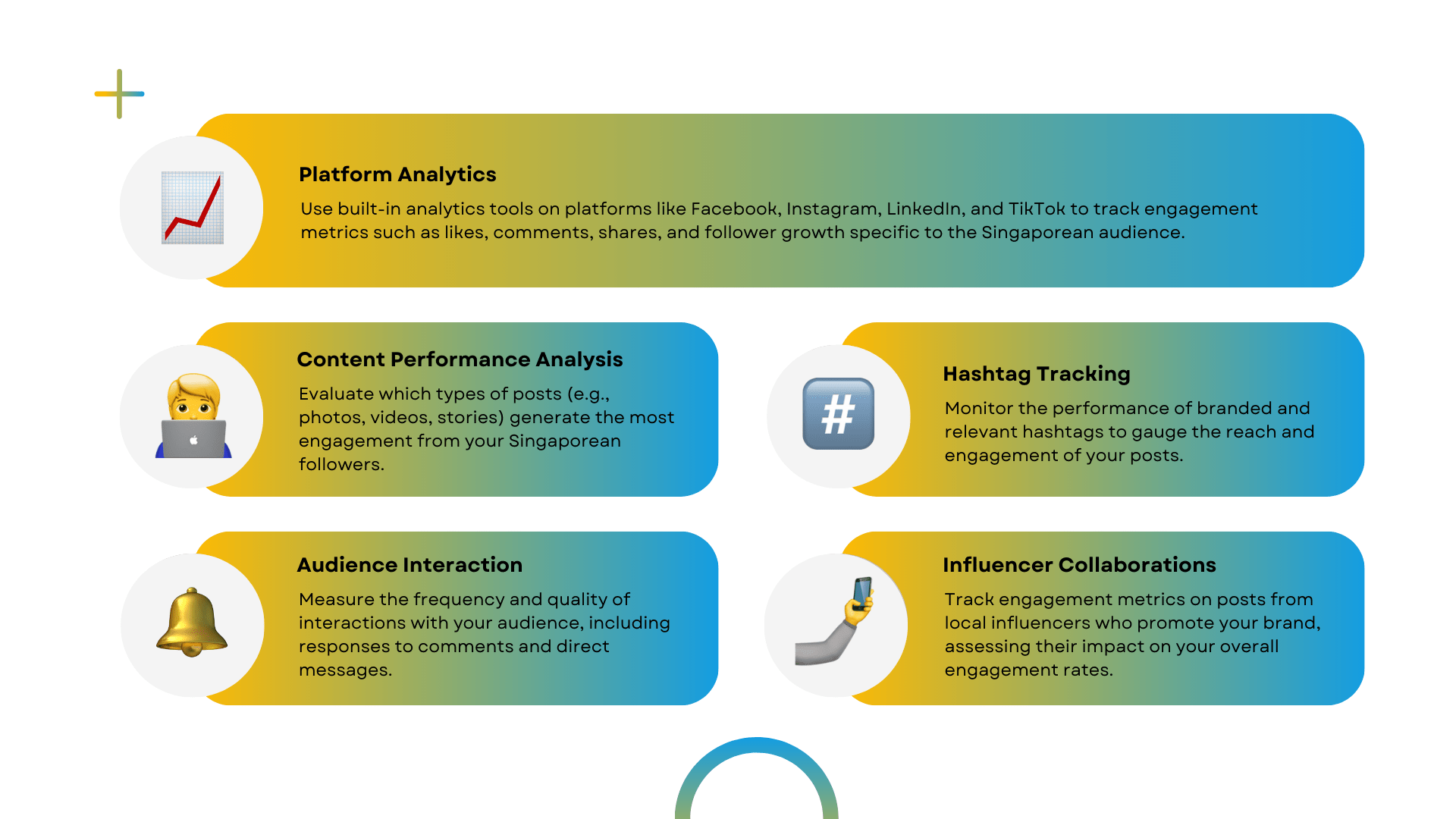
- Platform Analytics:
- Use built-in analytics tools on platforms like Facebook, Instagram, LinkedIn, and TikTok to track engagement metrics such as likes, comments, shares, and follower growth specific to the Singaporean audience.
- Content Performance Analysis:
- Evaluate which types of posts (e.g., photos, videos, stories) generate the most engagement from your Singaporean followers.
- Hashtag Tracking:
- Monitor the performance of branded and relevant hashtags to gauge the reach and engagement of your posts.
- Audience Interaction:
- Measure the frequency and quality of interactions with your audience, including responses to comments and direct messages.
- Influencer Collaborations:
- Track engagement metrics on posts from local influencers who promote your brand, assessing their impact on your overall engagement rates.
Potential Tools:
- Hootsuite:
- Hootsuite offers comprehensive analytics to track and measure social media engagement across multiple platforms.
- Sprout Social:
- This tool provides detailed engagement metrics and insights, helping you understand your audience’s interaction with your brand.
- BuzzSumo:
- BuzzSumo allows you to track social media engagement on content, giving insights into what types of posts are most engaging.
- Socialbakers:
- A social media marketing tool that tracks engagement metrics and provides comparative insights against competitors.
- Iconosquare:
- Specialises in Instagram and Facebook analytics, offering detailed engagement metrics to help refine your social media strategy.
Example of Good Social Media Engagement in Singapore:
Duolingo has successfully harnessed social media engagement to boost brand awareness and loyalty in Singapore. Their quirky and humorous posts resonate well with the local audience, generating high levels of likes, shares, comments, and user-generated content. By incorporating Singaporean cultural references and engaging with local influencers, Duolingo maintains a strong presence on social media, reflecting high engagement levels and fostering a loyal customer base.
6)Website Traffic
Website traffic, especially the number of unique visitors and their behaviour on your site, serves as a key indicator of brand awareness. Tracking how many people visit your site, how they found it, and what they do once they’re there can offer valuable insights. Here’s how to measure website traffic effectively in Singapore, along with tools and examples of successful traffic metrics.
Specific Ways to Measure Website Traffic in Singapore:
- Visitor Analysis:
- Track the number of unique visitors, page views, and sessions to understand the overall traffic to your website.
- Traffic Sources:
- Identify where your visitors are coming from, whether it’s organic search, direct visits, social media, or referral sites.
- User Behaviour:
- Analyse what visitors do once they are on your site, including the pages they visit, time spent on each page, and the bounce rate.
- Geographic Insights:
- Use geo-targeting features to focus on website traffic coming specifically from Singapore, providing insights into local engagement.
- Conversion Tracking:
- Measure conversions and goals, such as completed purchases or form submissions, to assess the effectiveness of your website in driving desired actions.
Potential Tools:
- Google Analytics:
- A comprehensive tool for tracking website traffic, user behaviour, traffic sources, and conversion rates. It’s essential for understanding how users interact with your site.
- SEMrush:
- Offers detailed insights into traffic sources, competitor analysis, and organic search performance.
- Hotjar:
- Provides heatmaps and session recordings to see exactly how visitors interact with your site, helping you improve user experience.
- Moz:
- An SEO tool that can help track organic traffic and keyword performance, giving insights into how your content attracts visitors.
- Ahrefs:
- Another SEO tool that provides in-depth analysis of organic search traffic, backlink profile, and overall site performance.
Example of Good Website Traffic in Singapore:
Love, Bonito, a popular fashion brand in Singapore, effectively uses website traffic metrics to gauge brand awareness. By leveraging Google Analytics, they track unique visitors, user behaviour, and conversion rates. The brand’s high direct traffic reflects strong brand awareness and loyalty among Singaporean consumers. Love, Bonito’s strategic use of SEO, social media marketing, and influencer collaborations drives consistent traffic to their site, resulting in increased sales and customer engagement.
7)Search Volume Data
Search volume data indicates how often your brand is searched for online, offering valuable insights into brand interest and awareness. Here’s how to measure and interpret search volume data effectively in Singapore, along with recommended tools and examples.
Specific Ways to Measure Search Volume Data in Singapore:
- Keyword Analysis:
- Identify and track the volume of searches for your brand name and related keywords. This helps understand how often people are looking for your brand online.
- Trend Monitoring:
- Monitor search trends over time to see if interest in your brand is increasing, decreasing, or remaining stable.
- Geographic Focus:
- Use geo-targeting features to focus specifically on search volume data from Singapore, providing insights into local interest and engagement.
- Competitive Analysis:
- Compare your brand’s search volume with competitors to gauge your brand’s position in the market.
- Seasonal Trends:
- Analyse seasonal variations in search volume to understand peak times of interest and plan marketing campaigns accordingly.
Potential Tools:
- Google Trends:
- Provides real-time data on search trends, allowing you to see how often your brand and related keywords are being searched.
- SEMrush:
- Offers detailed keyword analysis, including search volume, trends, and competitive insights.
- Ahrefs:
- Tracks keyword performance, search volume, and trends over time, helping you understand how your brand is performing online.
- Google Keyword Planner:
- A tool within Google Ads that provides search volume data and keyword trends, useful for planning and optimising your search campaigns.
Example of Good Search Volume Data in Singapore:
Shopee, a leading e-commerce platform in Singapore, effectively utilises search volume data to track and enhance brand awareness. By leveraging tools like Google Trends and SEMrush, Shopee monitors the frequency and trends of searches related to their platform. A rising search volume trend for “Shopee Singapore” and related keywords indicates growing interest and awareness among Singaporeans. This data helps Shopee tailor their marketing strategies, optimise their online presence, and stay ahead of competitors.
8) Branded Search Traffic
Branded search traffic measures the number of visitors who reach your website through searches that specifically include your brand name. This metric is crucial as it indicates strong brand recognition and a clear intent to engage with your brand directly. Here’s how to measure and understand branded search traffic effectively in Singapore.
Specific Ways to Measure Branded Search Traffic:
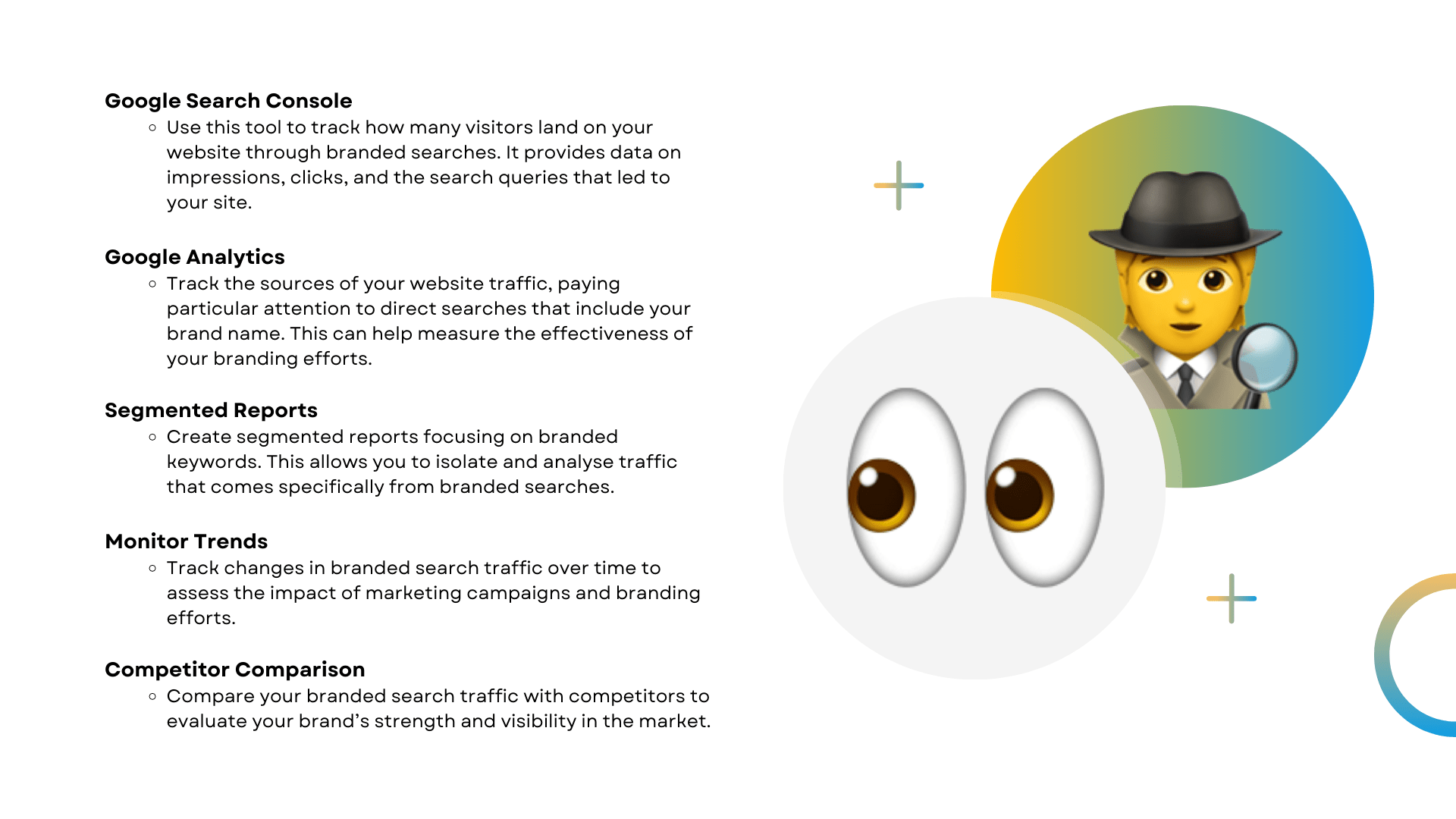
- Google Search Console:
- Use this tool to track how many visitors land on your website through branded searches. It provides data on impressions, clicks, and the search queries that led to your site.
- Google Analytics:
- Track the sources of your website traffic, paying particular attention to direct searches that include your brand name. This can help measure the effectiveness of your branding efforts.
- Segmented Reports:
- Create segmented reports focusing on branded keywords. This allows you to isolate and analyse traffic that comes specifically from branded searches.
- Monitor Trends:
- Track changes in branded search traffic over time to assess the impact of marketing campaigns and branding efforts.
- Competitor Comparison:
- Compare your branded search traffic with competitors to evaluate your brand’s strength and visibility in the market.
Potential Tools:
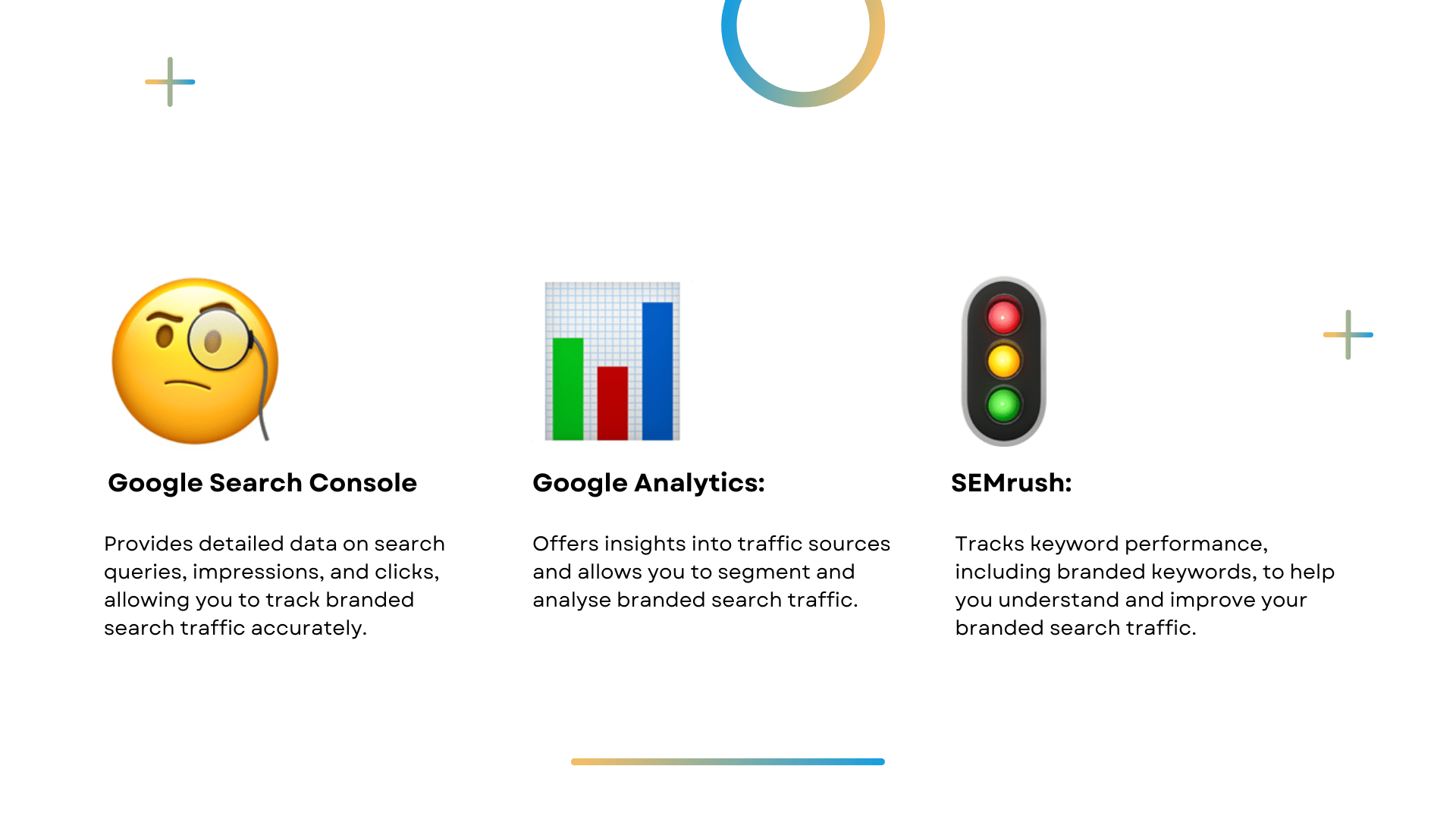
- Google Search Console:
- Provides detailed data on search queries, impressions, and clicks, allowing you to track branded search traffic accurately.
- Google Analytics:
- Offers insights into traffic sources and allows you to segment and analyse branded search traffic.
- SEMrush:
- Tracks keyword performance, including branded keywords, to help you understand and improve your branded search traffic.
Example of Good Branded Search Traffic in Singapore:
Grab, a leading ride-hailing and delivery service in Singapore, exemplifies strong branded search traffic. By using tools like Google Search Console and SEMrush, Grab tracks the number of visitors reaching their site through searches like “Grab Singapore” or “Grab app”. Consistently high branded search traffic indicates that consumers recognise and seek out Grab specifically, reflecting strong brand awareness and loyalty. This data helps Grab optimise their marketing strategies, improve user engagement, and maintain their market leadership.
9) Media Mentions
Tracking how often and where your brand is mentioned in the media provides valuable insights into its visibility and public perception. This metric is crucial for understanding your brand’s reach and influence in the market. Here’s how to measure and understand media mentions effectively.
Specific Ways to Measure Media Mentions:
- Media Monitoring Tools:
- Use tools like Meltwater and Cision to track mentions of your brand across various media channels, including news websites, blogs, and social media.
- Google Alerts:
- Set up alerts for your brand name to receive notifications whenever it is mentioned online. This can help you stay updated on new mentions and trends.
- Press Coverage Analysis:
- Analyse the frequency, sentiment, and context of media mentions to understand how your brand is being portrayed and perceived.
- Report Generation:
- Generate regular reports summarising the number of media mentions, key publications, and the overall sentiment to assess your brand’s media presence.
- Competitor Benchmarking:
- Compare your media mentions with competitors to gauge your brand’s relative visibility and reputation in the industry.
Potential Tools:
- Meltwater:
- Offers comprehensive media monitoring, analytics, and reporting to track and analyse your brand’s media mentions.
- Cision:
- Provides detailed insights into media coverage, including sentiment analysis and reach metrics, to help you understand your brand’s media impact.
- Google Alerts:
- Simple and effective tool for tracking mentions of your brand online. It helps you stay informed about new coverage and mentions in real-time.
Example of Effective Media Mentions in Singapore:
Singapore Airlines frequently monitors media mentions to maintain its reputation as a leading global airline. By using tools like Meltwater and Cision, Singapore Airlines tracks its coverage in major news outlets, travel blogs, and social media. Frequent positive mentions, particularly in reputable sources, enhance its credibility and brand awareness. This data helps Singapore Airlines adjust its PR strategies, respond to negative coverage promptly, and reinforce its brand image as a premium airline.
10) Customer Surveys
Customer surveys are a direct and effective way to measure brand awareness. By asking targeted questions, you can gather valuable qualitative data on how your brand is perceived and recognised by your audience. Here’s how to implement and analyse customer surveys to track brand awareness.
Specific Ways to Measure Customer Surveys:
- Survey Design:
- Craft questions that directly address brand awareness, such as “How did you first hear about our brand?” and “Can you name any products or services we offer?”
- Distribution Channels:
- Use multiple channels to distribute your surveys, such as email, social media, and in-store kiosks, to reach a diverse audience.
- Incentives for Participation:
- Offer incentives like discounts, freebies, or entry into a prize draw to encourage more responses and ensure a higher participation rate.
- Regular Frequency:
- Conduct surveys regularly, such as quarterly or bi-annually, to track changes in brand awareness over time.
- Data Analysis:
- Analyse the survey responses to identify trends, strengths, and areas for improvement. Look for common themes in how customers recognise and perceive your brand.
Potential Tools:
- SurveyMonkey:
- A versatile survey tool that allows you to create, distribute, and analyse surveys with ease.
- Google Forms:
- A free and user-friendly option for creating surveys and collecting responses in a structured format.
- Typeform:
- Known for its engaging and interactive survey designs, making it more likely to capture detailed responses from participants.
Example of Effective Customer Surveys in Singapore:
FairPrice, a leading supermarket chain in Singapore, uses customer surveys to gauge brand awareness and customer satisfaction. They ask questions about how customers heard about their latest promotions, their familiarity with FairPrice’s house brands, and their overall shopping experience. By regularly analysing survey data, FairPrice can understand customer preferences, improve marketing strategies, and enhance the overall shopping experience. This feedback loop helps maintain strong brand recognition and loyalty.
11) Influencer Reach
Influencer marketing can significantly amplify brand awareness by leveraging the follower base and credibility of influential personalities. Here’s how to measure the reach and impact of your influencer campaigns.
Specific Ways to Measure Influencer Reach:
- Follower Count:
- Assess the total follower count of the influencers you collaborate with to estimate potential reach.
- Engagement Metrics:
- Track likes, comments, shares, and overall engagement on posts related to your brand. High engagement rates indicate that the content resonates with the audience.
- Unique Impressions:
- Measure the number of unique users who have seen the content. This metric provides insight into the breadth of your campaign’s reach.
- Referral Traffic:
- Use tracking links or promo codes to measure how much traffic and sales are driven by influencer posts.
- Content Performance:
- Analyse the performance of different types of content (e.g., photos, videos, stories) to determine what works best for your brand.
Potential Tools:
- Traackr:
- A comprehensive influencer marketing platform that helps you track and analyse the performance of your influencer campaigns.
- AspireIQ:
- This tool connects brands with influencers and provides detailed analytics on campaign reach and engagement.
- Hootsuite Insights:
- Use Hootsuite’s advanced analytics to measure the impact of influencer collaborations on your social media reach and engagement.
Example of Effective Influencer Reach in Singapore:
CakeResume, a popular resume-building platform in Singapore, effectively uses influencer marketing to boost brand awareness among job seekers and professionals. They collaborate with local career coaches and industry experts who share their experiences and tips on creating standout resumes using CakeResume. By tracking the reach and engagement of these influencer posts, CakeResume can measure the success of their campaigns. Influencers often use referral codes or links, driving traffic to the platform and providing measurable results. This strategic use of influencer reach helps CakeResume establish itself as a go-to resource for career development in Singapore.
12) Referral Traffic
Referral traffic measures the number of visitors who come to your website from other sites. This metric is essential for understanding the effectiveness of your partnerships, guest posts, and social media efforts.
Specific Ways to Measure Referral Traffic:
- Google Analytics:
- Use Google Analytics to track referral sources. Navigate to Acquisition > All Traffic > Referrals to see which external sites are driving traffic to your website.
- UTM Parameters:
- Implement UTM parameters in your URLs to track the performance of specific campaigns and content shared on external sites.
- Backlink Analysis:
- Conduct a backlink analysis using tools like Ahrefs or Moz to identify which sites are linking to your content and how much traffic they are generating.
- Partnership Tracking:
- Monitor traffic from partner websites and guest posts to evaluate the success of these collaborations.
Potential Tools:
- Google Analytics:
- A comprehensive tool that provides detailed insights into referral traffic, including the number of visitors and their behaviour on your site.
- Ahrefs:
- This tool offers in-depth backlink analysis, helping you identify which sites are driving referral traffic to your website.
- Moz:
- Moz’s tools can track your site’s backlinks and referral traffic, offering valuable data on the effectiveness of your SEO and partnership efforts.
Example of Effective Referral Traffic in Singapore:
Chope, a popular restaurant reservation platform in Singapore, effectively leverages referral traffic through strategic partnerships and guest posts. By collaborating with food blogs, lifestyle websites, and social media influencers, Chope drives significant traffic to its site. For instance, a guest post on a renowned food blog or a feature on a lifestyle website often results in a spike in referral traffic, as tracked by Google Analytics. This strategy not only increases visibility but also enhances Chope’s credibility and user base.
13) Content Shares and Backlinks
Content shares and backlinks are essential indicators of how well your content resonates with your audience and its perceived value.
Specific Ways to Measure Content Shares and Backlinks:
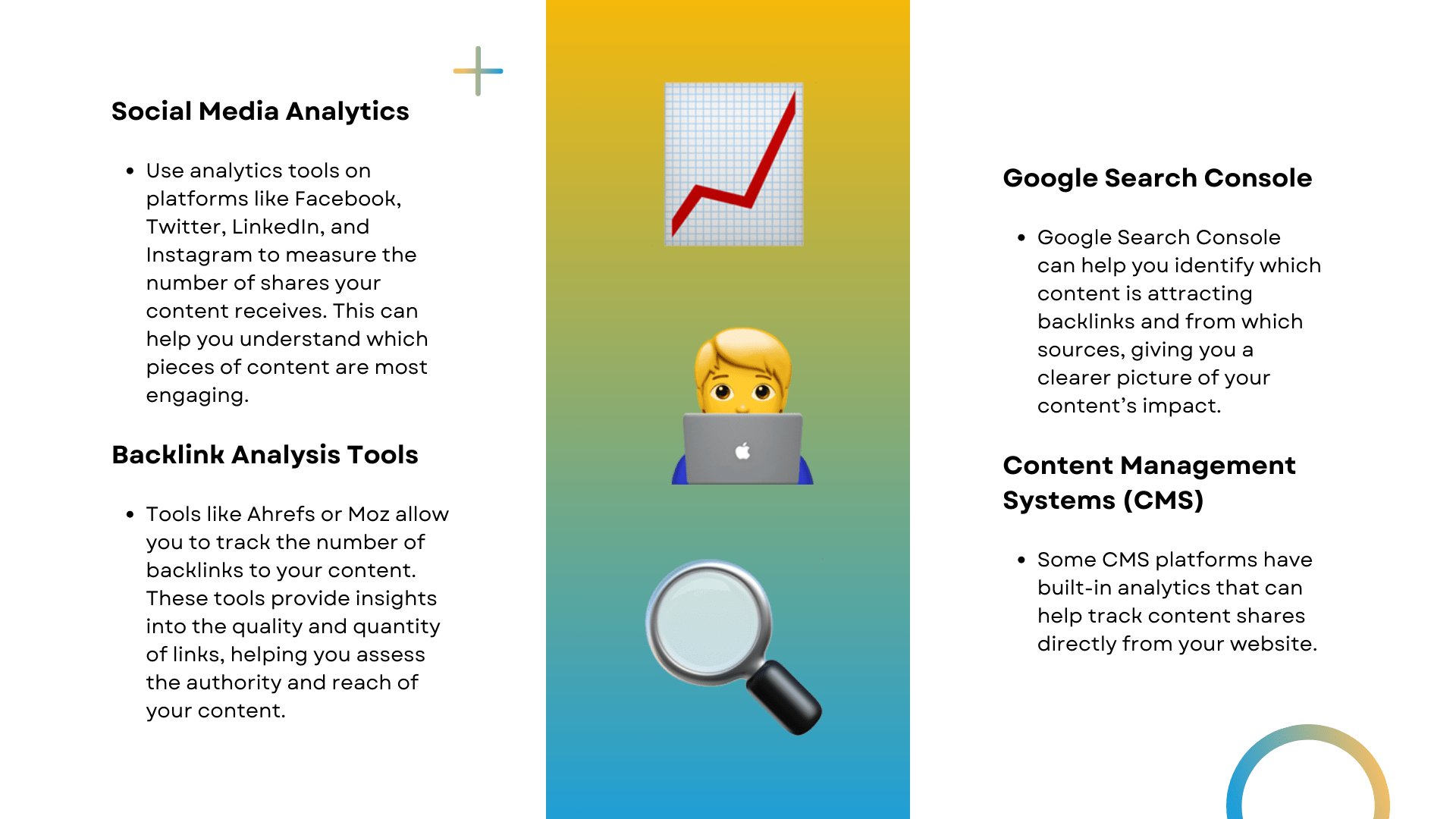
- Social Media Analytics:
- Use analytics tools on platforms like Facebook, Twitter, LinkedIn, and Instagram to measure the number of shares your content receives. This can help you understand which pieces of content are most engaging.
- Backlink Analysis Tools:
- Tools like Ahrefs or Moz allow you to track the number of backlinks to your content. These tools provide insights into the quality and quantity of links, helping you assess the authority and reach of your content.
- Google Search Console:
- Google Search Console can help you identify which content is attracting backlinks and from which sources, giving you a clearer picture of your content’s impact.
- Content Management Systems (CMS):
- Some CMS platforms have built-in analytics that can help track content shares directly from your website.
Potential Tools:
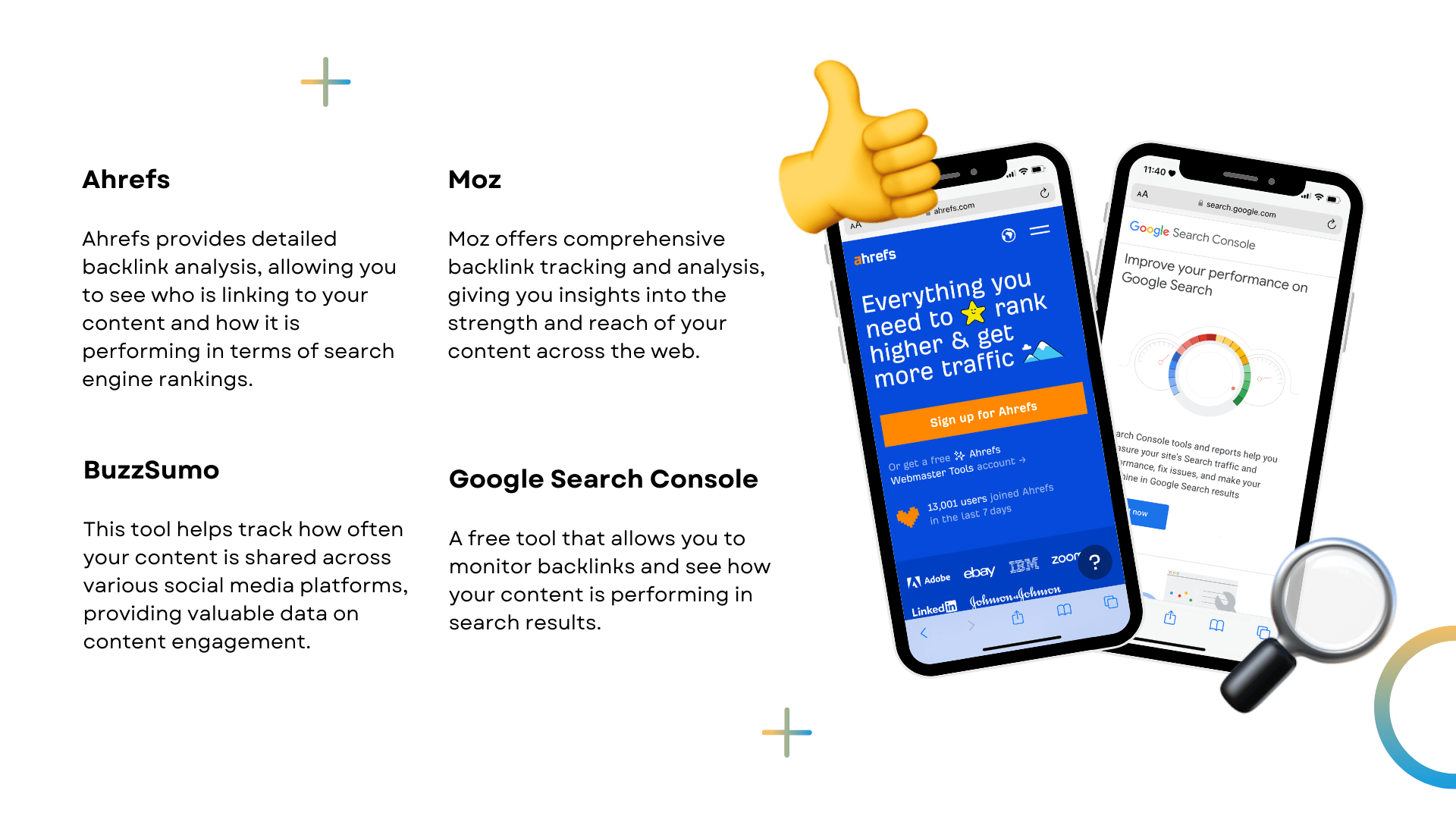
- Ahrefs:
- Ahrefs provides detailed backlink analysis, allowing you to see who is linking to your content and how it is performing in terms of search engine rankings.
- Moz:
- Moz offers comprehensive backlink tracking and analysis, giving you insights into the strength and reach of your content across the web.
- BuzzSumo:
- This tool helps track how often your content is shared across various social media platforms, providing valuable data on content engagement.
- Google Search Console:
- A free tool that allows you to monitor backlinks and see how your content is performing in search results.
Example of Effective Content Shares and Backlinks in Singapore:
Articles and resources provided by CakeResume often receive high numbers of shares on social media due to their engaging and valuable content tailored to job seekers and professionals. Additionally, CakeResume’s content attracts numerous backlinks from reputable sites, including career advice blogs and news outlets, which significantly boosts its online authority and reach. By using tools like Ahrefs and BuzzSumo, CakeResume tracks the performance of its content, allowing the platform to refine its strategy and maintain its position as a leading career development resource in Singapore.
Conclusion: How To Measure Your Brand?
Tracking these 13 key metrics provides a comprehensive view of your brand awareness and its impact. Regularly analysing these metrics helps you refine your marketing strategies, ensuring they effectively enhance your brand’s visibility and reputation. By staying vigilant and adaptive, you can maintain a strong brand presence and foster long-term customer loyalty.



